Impressionism: Art and Modernity

















In 1874, a group of artists called the Anonymous Society of Painters, Sculptors, Printmakers, etc. organized an exhibition in Paris that launched the movement called Impressionism. Its founding members included Claude Monet, Edgar Degas, and Camille Pissarro, among others. The group was unified only by its independence from the official annual Salon, for which a jury of artists from the Académie des Beaux-Arts selected artworks and awarded medals. The independent artists, despite their diverse approaches to painting, appeared to contemporaries as a group. While conservative critics panned their work for its unfinished, sketchlike appearance, more progressive writers praised it for its depiction of modern life. Edmond Duranty, for example, in his 1876 essay La Nouvelle Peinture (The New Painting), wrote of their depiction of contemporary subject matter in a suitably innovative style as a revolution in painting. The exhibiting collective avoided choosing a title that would imply a unified movement or school, although some of them subsequently adopted the name by which they would eventually be known, the Impressionists. Their work is recognized today for its modernity, embodied in its rejection of established styles, its incorporation of new technology and ideas, and its depiction of modern life.
| More
Claude Monet's Impression, Sunrise (Musée Marmottan Monet, Paris) exhibited in 1874, gave the Impressionist movement its name when the critic Louis Leroy accused it of being a sketch or "impression," not a finished painting. It demonstrates the techniques many of the independent artists adopted: short, broken brushstrokes that barely convey forms, pure unblended colors, and an emphasis on the effects of light. Rather than neutral white, grays, and blacks, Impressionists often rendered shadows and highlights in color. The artists' loose brushwork gives an effect of spontaneity and effortlessness that masks their often carefully constructed compositions, such as in Alfred Sisley's 1878 Allée of Chestnut Trees (1975.1.211). This seemingly casual style became widely accepted, even in the official Salon, as the new language with which to depict modern life.
In addition to their radical technique, the bright colors of Impressionist canvases were shocking for eyes accustomed to the more sober colors of Academic painting. Many of the independent artists chose not to apply the thick golden varnish that painters customarily used to tone down their works. The paints themselves were more vivid as well. The nineteenth century saw the development of synthetic pigments for artists' paints, providing vibrant shades of blue, green, and yellow that painters had never used before. Édotard Manet's 1874 Boating (29.100.115), for example, features an expanse of the new Cerulean blue and synthetic ultramarine. Depicted in a radically cropped, Japanese-inspired composition, the fashionable boater and his companion embody modernity in their form, their subject matter, and the very materials used to paint them.
Such images of suburban and rural leisure outside of Paris were a popular subject for the Impressionists, notably Monet and Pierre-Auguste Renoir. Several of them lived in the country for part or all of the year. New railway lines radiating out from the city made travel so convenient that Parisians virtually flooded into the countryside every weekend. While some of the Impressionists, such as Pissarro, focused on the daily life of local villagers in Pontoise, most preferred to depict the vacationers' rural pastimes. The boating and bathing establishments that flourished in these regions became favorite motifs. In his 1869 La Grenouillère, for example, Monet's characteristically loose painting style complements the leisure activities he portrays. Landscapes, which figure prominently in Impressionist art, were also brought up to date with innovative compositions, light effects, and use of color. Monet in particular emphasized the modernization of the landscape by including railways and factories, signs of encroaching industrialization that would have seemed inappropriate to the Barbizon artists of the previous generation.
Perhaps the prime site of modernity in the late nineteenth century was the city of Paris itself, renovated between 1853 and 1870 under Emperor Napoleon III. His prefect, Baron Haussmann, laid the plans, tearing down old buildings to create more open space for a cleaner, safer city. Also contributing to its new look was the Siege of Paris during the Franco-Prussian War (1870–71), which required reconstructing the parts of the city that had been destroyed. Impressionists such as Pissarro and Gustave Caillebotte enthusiastically painted the renovated city, employing their new style to depict its wide boulevards, public gardens, and grand buildings. While some focused on the cityscapes, others turned their sights to the city's inhabitants. The Paris population explosion after the Franco-Prussian War gave them a tremendous amount of material for their scenes of urban life. Characteristic of these scenes was the mixing of social classes that took place in public settings. Degas and Caillebotte focused on working people, including singers and dancers, as well as workmen. Others, including Berthe Morisot and Mary Cassatt, depicted the privileged classes. The Impressionists also painted new forms of leisure, including theatrical entertainment (such as Cassatt's 1878 In the Loge [Museum of Fine Arts, Boston]), cafés, popular concerts, and dances. Taking an approach similar to Naturalist writers such as Émile Zola, the painters of urban scenes depicted fleeting yet typical moments in the lives of characters they observed. Caillebotte's 1877 Paris Street, Rainy Day  (Art Institute, Chicago) exemplifies how these artists abandoned sentimental depictions and explicit narratives, adopting instead a detached, objective view that merely suggests what is going on.
(Art Institute, Chicago) exemplifies how these artists abandoned sentimental depictions and explicit narratives, adopting instead a detached, objective view that merely suggests what is going on.
The independent collective had a fluid membership over the course of the eight exhibitions it organized between 1874 and 1886, with the number of participating artists ranging from nine to thirty. Pissarro, the eldest, was the only artist who exhibited in all eight shows, while Morisot participated in seven. Ideas for an independent exhibition had been discussed as early as 1867, but the Franco-Prussian War intervened. The painter Frédéric Bazille, who had been leading the efforts, was killed in the war. Subsequent exhibitions were headed by different artists. Philosophical and political differences among the artists led to heated disputes and fractures, causing fluctuations in the contributors. The exhibitions even included the works of more conservative artists who simply refused to submit their work to the Salon jury. Also participating in the independent exhibitions were Paul Cézanne and Paul Gauguin, whose later styles grew out of their early work with the Impressionists.
The last of the independent exhibitions in 1886 also saw the beginning of a new phase in avant-garde painting. By this time, few of the participants were working in a recognizably Impressionist manner. Most of the core members were developing new, individual styles that caused ruptures in the group's tenuous unity. Pissarro promoted the participation of Georges Seurat and Paul Signac, in addition to adopting their new technique based on points of pure color, known as Neo-Impressionism.
The young Gauguin was making forays into Primitivism. The nascent Symbolist Odilon Redon also contributed, though his style was unlike that of any other participant. Because of the group's stylistic and philosophical fragmentation, and because of the need for assured income, some of the core members such as Monet and Renoir exhibited in venues where their works were more likely to sell.
Its many facets and varied participants make the Impressionist movement difficult to define. Indeed, its life seems as fleeting as the light effects it sought to capture. Even so, Impressionism was a movement of enduring consequence, as its embrace of modernity made it the springboard for later avant-garde art in Europe.
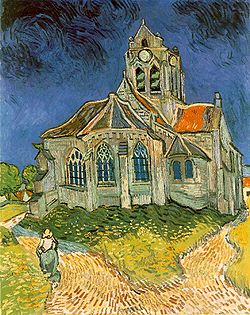

Van Gogh: The Church at Auvers (1890)
The visual arts are art forms that create works which are primarily visual in nature, such as ceramics, drawing, painting, sculpture, printmaking, design, crafts, and often modern visual arts (photography, video, and filmmaking) and architecture. These definitions should not be taken too strictly as many artistic disciplines (performing arts, conceptual art, textile arts) involve aspects of the visual arts as well as arts of other types. Also included within the visual arts are the applied arts such as industrial design, graphic design, fashion design, interior design and decorative art.
The increasing tendency to privilege painting, and to a lesser degree sculpture, above other arts has been a feature of Western art as well as East Asian art. In both regions painting has been seen as relying to the highest degree on the imagination of the artist, and the furthest removed from manual labour - in Chinese painting the most highly valued styles were those of "scholar-painting", at least in theory practiced by gentleman amateurs. The Western hierarchy of genres reflected similar attitudes.
Education and training
Training in the visual arts has generally been through variations of the apprentice and workshop system. In Europe the Renaissance movement to increase the prestige of the artist led to the academy system for training artists, and today most train in art schools at a tertiary level. Visual arts have now become an elective subject in most education systems.
Painting
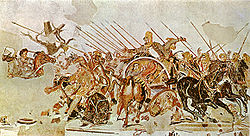

Mosaic of Battle of Issus
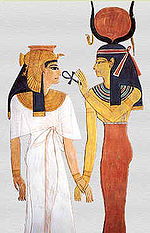

Nefertari with Isis
Painting taken literally is the practice of applying pigment suspended in a carrier (or medium) and a binding agent (a glue) to a surface (support) such as paper, canvas or a wall. However, when used in an artistic sense it means the use of this activity in combination with drawing, composition and other aesthetic considerations in order to manifest the expressive and conceptual intention of the practitioner. Painting is also used to express spiritual motifs and ideas; sites of this kind of painting range from artwork depicting mythological figures on pottery to The Sistine Chapel to the human body itself.
Origins and early history
Like drawing, painting has its origins in caves and on rock faces. The finest examples, believed by some to be 32,000 years old, are in the Chauvet and Lascaux caves in southern France. In shades of red, brown, yellow and black, the paintings on the walls and ceilings are of bison, cattle, horses and deer.
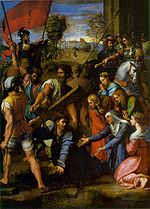

Raphael: Transfiguration (1520)
Paintings of human figures can be found in the tombs of ancient Egypt. In the great temple of Ramses II, Nefertari, his queen, is depicted being led by Isis. The Greeks contributed to the development of painting but much of their work has been lost. One of the best remaining representations is the mosaic of the Battle of Issus found at Pompeii which was probably based on a Greek painting. Greek and Roman art contributed to Byzantine art in the 4th century BC which initiated a tradition in icon painting.
The Renaissance
Apart from the illuminated manuscripts produced by monks during the Middle Ages, the next significant contribution to European art was from Italy's renaissance painters. From Giotto in the 13th century to Leonardo da Vinci and Raphael at the beginning of the 16th century, this was the richest period in Italian art as the chiaroscuro technique was used to create the illusion of 3-D space.
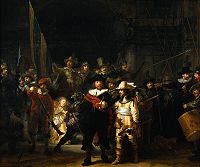

Rembrandt: The Night Watch
Painters in northern Europe too were influenced by the Italian school. Jan van Eyck from Belgium, Pieter Bruegel the Elder from the Netherlands and Hans Holbein the Younger from Germany are among the most successful painters of the times. They used the glazing technique with oils to achieve depth and luminosity.
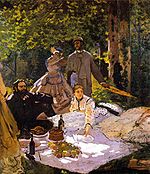

Claude Monet: Déjeuner sur l'herbe (1866)
Dutch masters
The 17th century saw the emergence of the great Dutch masters such as the versatile Rembrandt who is especially remembered for his portraits and Bible scenes, and Vermeer who specialized in interior scenes of Dutch life.
Impressionism
Impressionism began in France in the 19th century with a loose association of artists including Claude Monet, Pierre-Auguste Renoir and Paul Cézanne who brought a new freely brushed style to painting, often choosing to paint realistic scenes of modern life outside rather than in the studio. They achieved intense colour vibration by using pure, unmixed colours and short brush strokes.
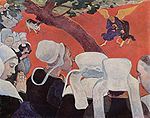

Paul Gauguin: The Vision After the Sermon (1888)
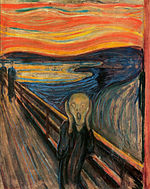

Edvard Munch: The Scream (1893)
Post-impressionism
Towards the end of the 19th century, several young painters took impressionism a stage further, using geometric forms and unnatural colour to depict emotions while striving for deeper symbolism. Of particular note are Paul Gauguin, who was strongly influenced by Asian, African and Japanese art, Vincent van Gogh, a Dutchman who moved to France where he drew on the strong sunlight of the south, and Toulouse-Lautrec, remembered for his vivid paintings of night life in the Paris district of Montmartre.
